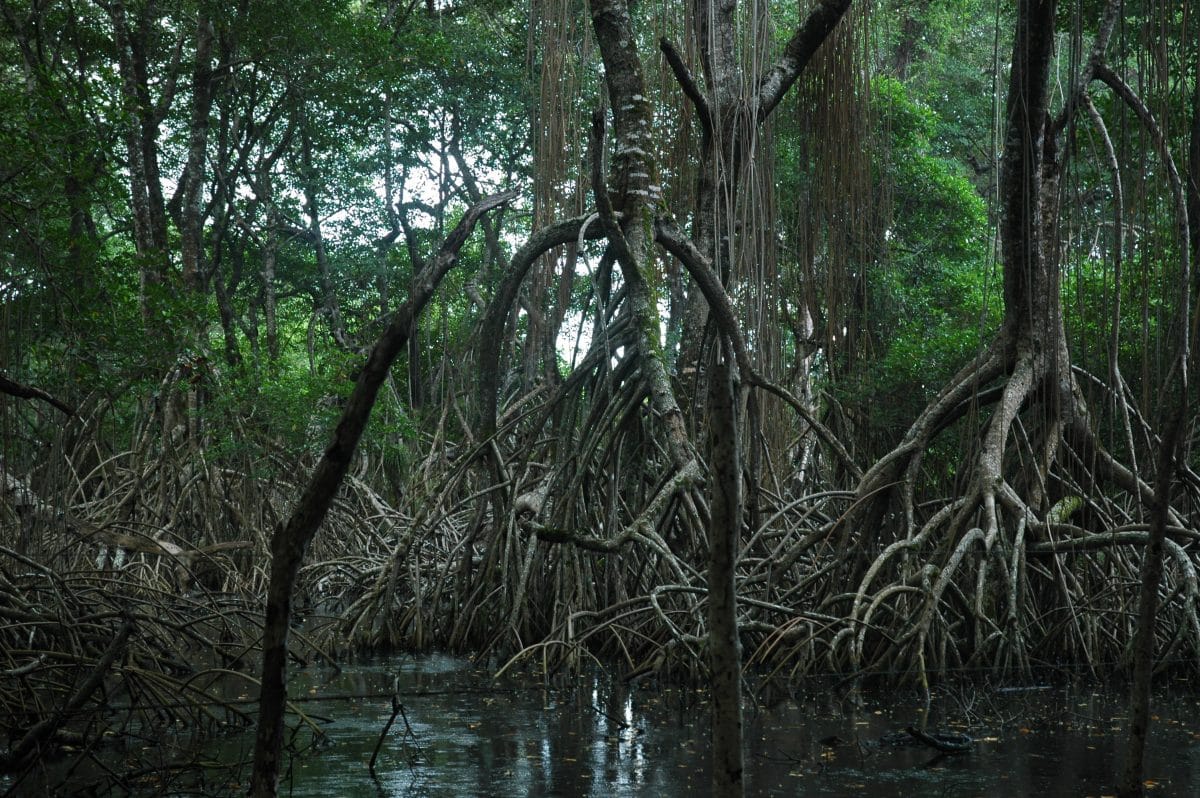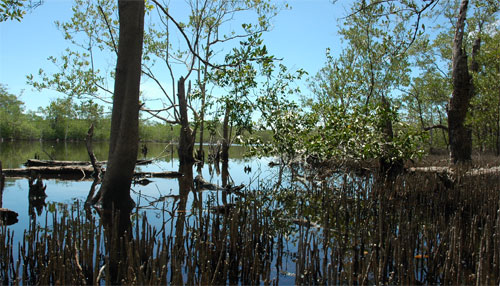A natural barrier against tsunamis, an immense reservoir of biodiversity and a natural "supermarket" for certain populations, mangroves are in danger. Today, numerous associations are implementing projects to protect it.
On the island ofUtila in the Caribbean Sea, just off the Honduran coast, a team of eco-volunteers is preparing to cross the mangrove swamp. Their mission: to release a small endemic iguana, which lives in the mangroves and feeds on crabs, in the middle of this watery kingdom of roots and light. Meanwhile, at the iguana station, other volunteers give guided tours to raise awareness of the importance of preserving the island's mangroves. Utila once needed neither a sewage treatment plant nor a sewer. The mangroves took care of evacuating the waste generated by the inhabitants. Today, of course, the situation has changed with theexplosion in tourism.
A few thousand kilometers away, on the island of Mayotte, the Mzouasia elementary school is proposing a law to the National Assembly for the creation of a national marine park including the mangrove. Here, the mangrove forest stretches along the edge of the lagoon for almost 1,000 km2.
These two actions are not isolated in the world. In recent years, there has been a growing awareness of the importance of protecting this ecosystem, which thrives mainly in the intertropics. Major organizations are now stepping up their efforts to preserve or replant mangrove forests, which in 1980 covered 19,800,000 hectares, according to FAO figures.
Such is the case of theNGO Mangrove Action Project ( MAP), which is present in nine countries in Asia, Africa and Latin America. MAP supports reforestation and education programs. Every year, children from schools located in mangrove areas are invited to take part in the Mangrove Art Calendar, a competition designed to give a voice to the children who live in this environment.
In terms of restoration and reforestation, the NGO sets up programs in partnership with fishermen to promote sustainable development. Numerous projects are currently underway, notably in Ecuador, Brazil, Guatemala, Thailand, Sri Lanka and Malaysia.
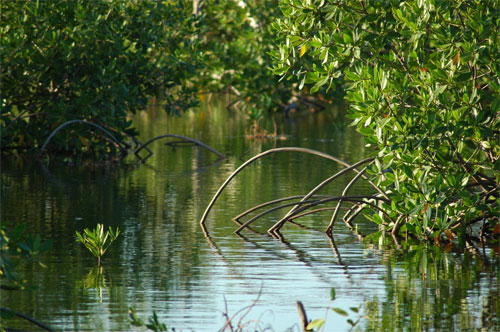
Shrimp farms under attack
This mobilization to save this ecosystem is no accident. It is a response to the accelerated disappearance of mangrove forests since the 1980s, mainly for economic reasons. According to FAO sources, mangrove forests lost 1,708,000 hectares between 1990 and 2000, when they represented 14,653,000 hectares.
The origin of this destruction varies from country to country. But as Jim Enright, coordinator of MAP Asia, points out, "the main cause of destruction is aquaculture and shrimp farming, especially in South-East Asia". This industry, operated by Western multinationals, is responsible for the disappearance of 65,000 hectares of mangroves in Thailand, the world's largest shrimp-importing country, and 665,000 hectares in Indonesia. Farming ponds are often built in mangrove swamps, as the water is easily replenished by the ebb and flow of the tides.
The industry is now worth an estimated $9 billion and provides jobs for around 1 million people in Sri Lanka and 700,000 in India. This financial contribution has an environmental as well as a social cost. When shrimp farming ponds are poorly constructed, seepage can reach the water table, causing high levels of salinization and making the water unfit for consumption, as was the case in India.
With the development of tourism, the coastline is also a victim of sometimes massive urbanization, often to the detriment of mangroves in inter-tropical zones. Human activity is increasingly encroaching on the sea to build villas, resorts and marinas. The mangroves are then drained, filled in by earthworks and the mangrove trees replaced by coconut palm groves, offering an image of the site more in keeping with the desires of tourists.
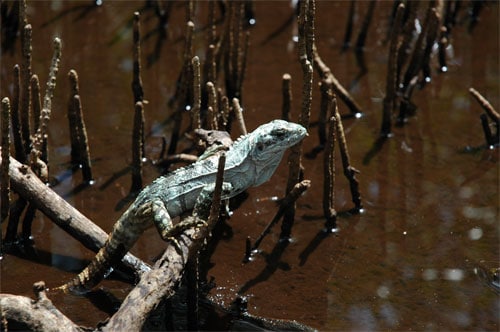
The influence of rising water
Another phenomenon that threatens these forests to a lesser extent is global warming and the resulting rise in sea levels. Mangroves, a veritable link between land and sea, are one of the first ecosystems to be affected by climate change.
According to a study published by the United Nations Environment Programme (UNEP), mangroves in the Pacific Ocean are currently under threat. The study, which covered 16 Pacific island states and territories, concludes that 13% of this forest is endangered. In the worst-affected areas of American Samoa, Fiji, Tuvalu and the Federated States of Micronesia, 50% of the mangroves could disappear.
Achim Steiner, the program's executive director, declared that "there are many compelling arguments in favor of combating climate change. The threats facing the mangroves of the Pacific, and therefore all the lowlands of the tropics, give us all the more reason to act." UNEP has therefore proposed a number of land-use strategies to help mitigate the effects of rising sea levels. For example, infrastructure could be moved further inland from the coast, allowing mangroves to spread further inland.
According to Jean-Michel Amouroux, a research fellow at the CNRS in Banyuls-sur-Mer, in many parts of the world "mangroves will somehow follow the rise in sea level by colonizing areas currently further inland. So rising sea levels would simply displace the mangroves.
Protection against tsunamis
If it were to disappear, however, an entire ecosystem would be destroyed. An ecosystem whose role is vital from both an economic and environmental point of view. Many populations have already paid the price for the destruction of mangrove forests, particularly in Asia.
Most scientists now agree that there would have been fewer victims of the December 26 2004 tsunami if the mangroves had been intact.
"A mangrove forest acts as a protective barrier for the population in the event of a tsunami. The wave is micro-diffused by the mangroves' aerial roots. It loses its energy very quickly," explains Jean-Michel Amouroux.
In 1960, a tsunami hit the coast of Bangladesh, in a place where the mangroves were intact. No one died.
On December 26, 2004, on the island of Nias, the population survived better because it was behind the mangrove, yet Nias was close to the epicenter.
In addition to its role as a natural breakwater, the mangrove has also been described as a "poor man's supermarket". One hectare of mangroves in the Philippines generates around four hundred kilos of fish, shrimps, crabs and molluscs every year. This is a vital resource for the people who live close to these forests.
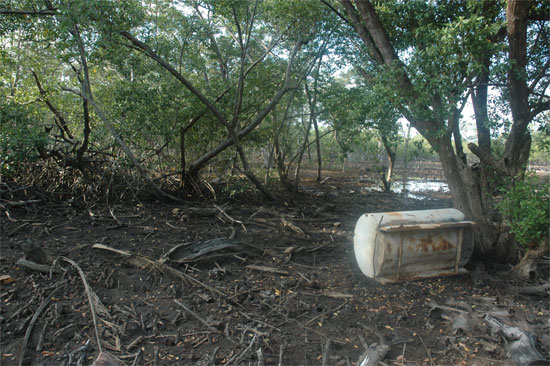
Mangroves are home to a rich and diverse fauna and provide wood forbuilding and heating. Some populations, notably in the Philippines, attribute medicinal virtues to mangroves.
Mangroves can also be exploited on a large scale, as was the case in Nigeria, where they were used for coal mining. Although the demand for charcoal has since declined, the wood is still exploited for a variety of purposes, including carpentry.
In Kenya and Tanzania, small poles are made from mangroves. They are renowned for their sturdiness and much sought-after in Arab countries, where they are exported in large numbers. In 1982, Kenya exported almost four million poles.
In this particular case, according to the FAO, the forest did not suffer as much as might have been expected, as the felling was selective and the mangrove was able to regenerate rapidly.
Other forests of this type have been sustainably managed, in some cases for over a hundred years. The Sundarbans, in India and Bangladesh, have been managed using a skimming system since 1892-1893, when the first forest management plan was implemented. The system has proved excellent for the sustainable management of this ecosystem. In the Sundarbans, separate annual cuttings are established for the extraction of timber, firewood and pulpwood.
Today, this mangrove is one of the largest in one piece. It has been a UNESCO World Heritage Site since 1987 and is renowned for its rich fauna, which includes 260 species of birds, the Bengal tiger and other endangered species such as the marine crocodile and the Indian python.
The challenge of sustainable development
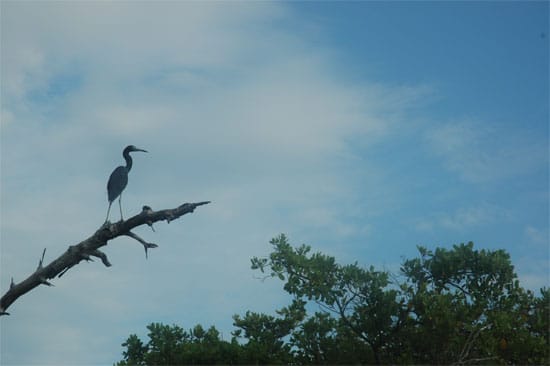
Most governments are now aware of the importance of developing sustainable management of mangrove forests. Their role in maintaining the social and environmental balance in inter-tropical zones is now widely recognized. As are the harmful effects of shrimp farming when ponds are built in the forest.
The authorities are therefore keen to manage their natural resources differently.
In the aftermath of the tsunami, Malaysia, Indonesia and Thailand announced their intention to implement mangrove reforestation policies. These policies are often overseen by NGOs such as MAP, and include the activities of fishermen.
In view of the economic activity derived from mangroves, estimated at an average of $900,000 per square kilometer, a return to traditional exploitation certainly seems impossible. What's more, as Jean-Michel Amouroux points out, "there would be a problem of overpopulation. On the other hand, "it is entirely possible to maintain shrimp farms by building basins behind the mangroves. All that's needed is a drainage and water supply system.
Other alternatives exist, notably with the development of green tourism and ecovolunteer missions.
In the Sundarbans, the United Nations Development Program is currently working with India and Bangladesh on a partnership to protect the biological diversity of these wetlands. This project should enable the extremely poor people who live near these sites to develop alternative sources of income, such as tourism. In this way, the local population will be less dependent on the exploitation of the forest.
Laurence Dupont
https://www.eco-volontaire.com/animaux-sauvages-vers-la-sixieme-extinction/
https://www.eco-volontaire.com/cheval-przewalski-mongolie/
https://www.eco-volontaire.com/chauves-souris/

